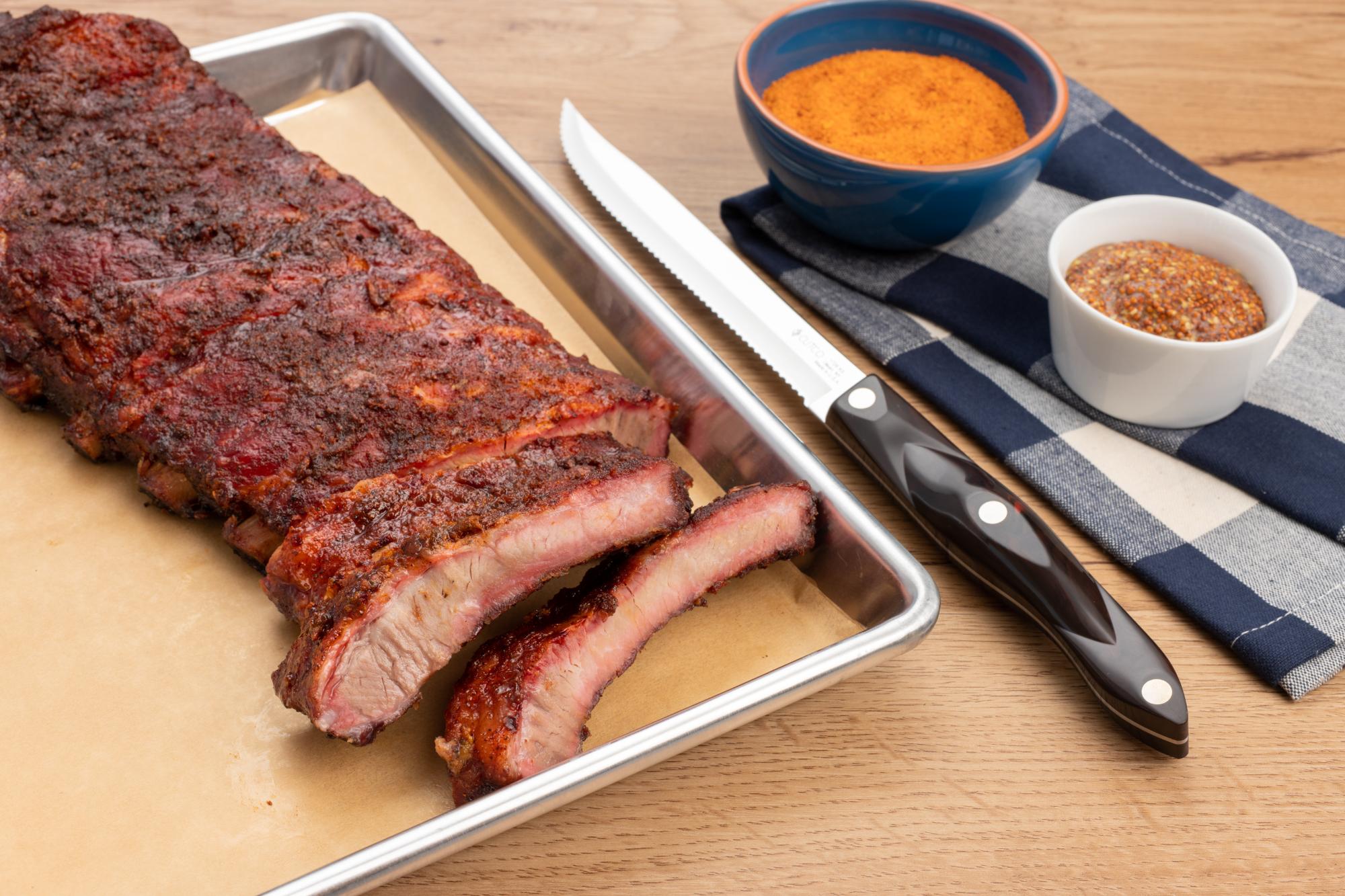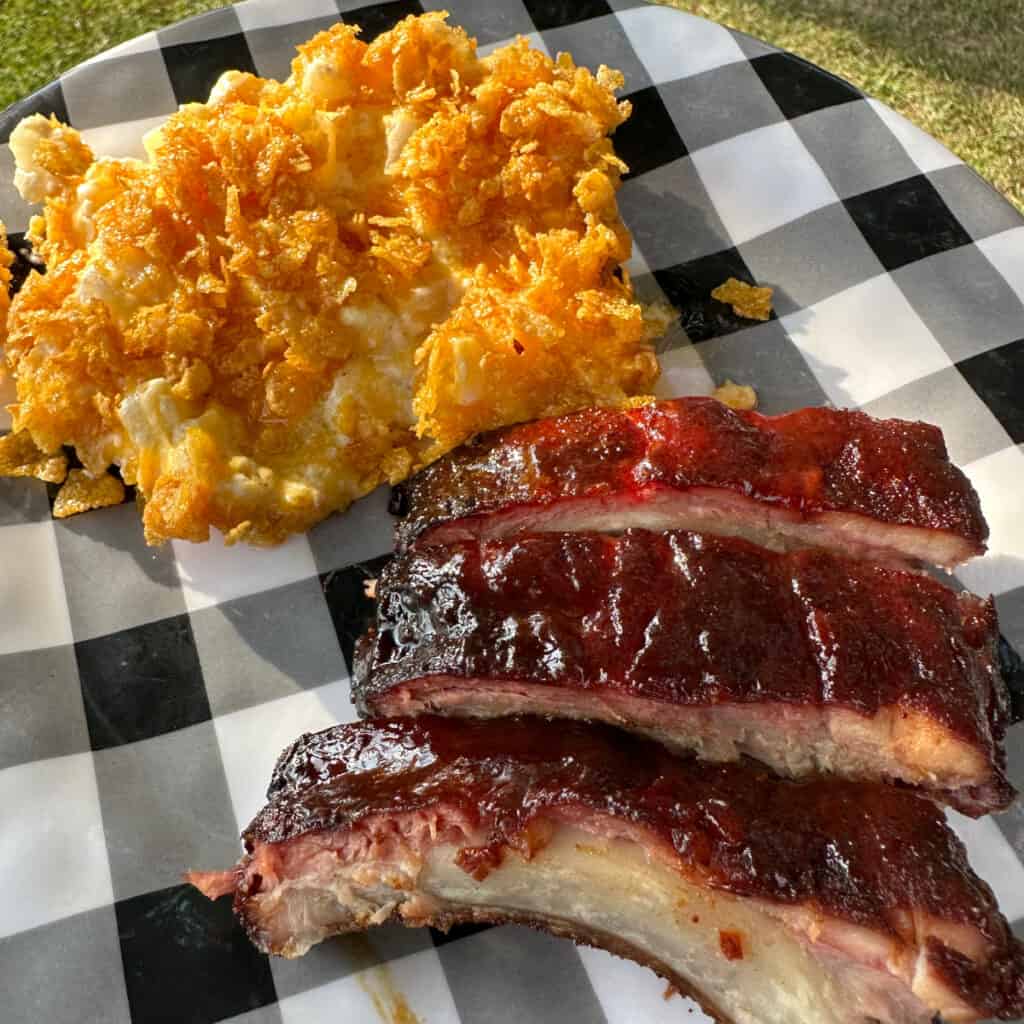Smoked Baby Back Ribs are one of my favorite things to cook outside. They’re great for game day or any day that ends in “y.” My wife’s favorite thing I make for her is always these, so she always asks, “When is your birthday?” Simple to follow, this recipe will give you perfect baby back ribs that are juicy, sticky, messy, and tasty! Smoked ribs with Cheesy Funeral Potatoes will not let you down!
Smoking pork ribs can seem intimidating for backyard grill masters. Getting them fall-off-the-bone tender without drying them out is an art. But have no fear, with just a few tips on temperature, time, and technique, you can achieve competition-worthy ribs every time you fire up the smoker.
In this article, I’ll walk you through everything you need to know to smoke mouthwatering juicy pork ribs that your family and friends will devour. We’ll cover
- Estimated cook times and temperatures
- Helpful equipment to have on hand
- How to prepare your ribs
- Maintaining proper temperature and smoke
- Basting and spritzing techniques
- How to test for doneness
- Resting, slicing, and serving
With the information in this guide, you’ll gain the confidence to smoke ribs like a pro pitmaster Let’s get started!
Estimated Smoking Times and Temperatures
The most important factors in smoking ribs are maintaining an even, low temperature over an extended period. The long, slow cooking is what helps break down the connective tissue in the meat, leading to fall-off-the-bone texture.
For baby back ribs, estimate 4-5 hours of smoking time. For meatier spare ribs, plan on 5-6 hours. These times can vary based on the size and thickness of your particular racks.
Aim to keep your smoker temperature between 225-250°F for the entire cook time. This low and slow approach allows the smoke to fully permeate the meat.
Here are some general timeframes to follow:
- Baby back ribs: 4-5 hours
- Spare ribs: 5-6 hours
- St. Louis cut ribs: 5-6 hours
Maintaining an even temperature in your smoker is crucial. Fluctuations can lead to uneven cooking. Use a quality thermometer and make adjustments as needed to the vents or fuel.
Helpful Equipment
Having the right gear on hand will make the rib smoking process much easier:
- Smoker: Charcoal, electric, offset, etc. As long as you can hold temps between 225-250°F.
- Thermometer: Monitor your smoker temp. A dual probe thermometer allows monitoring meat temp too.
- Tongs: Helpful for moving ribs around.
- Basting brush: For applying sauce and marinades.
- Spray bottle: For spritzing ribs with apple juice or other liquids.
- Disposable foil pan: Catches drippings from meat for easy cleanup.
- Oven mitts: Protect your hands from the heat.
- Cutting board and knife: For slicing up the finished ribs.
Preparing the Ribs
To get the best results, start by removing the thin membrane on the back of the ribs. This will allow the smoke and seasoning to better penetrate the meat.
Use a knife to loosen the membrane, grab hold of it with a paper towel, and peel it off. Season generously with a dry rub. Meatier ribs benefit from being rubbed the night before and left to marinate in the fridge.
When ready to cook, remove ribs from the fridge and let come closer to room temperature before smoking. Meat smokes best when not completely cold.
Maintaining Proper Temperature and Smoke
The key to perfectly smoked ribs is maintaining a consistent temperature in your smoker for the entire cook time. Uneven cooking temps can lead to dried out or underdone meat.
Aim to keep the temperature between 225-250°F. Use wood chips, chunks or logs for smoke flavor. Soaking them first can help extend burn time. Replenish the wood as needed if smoke starts to die down.
For charcoal smokers, monitor the coals and only add more if needed to maintain the target temp. For electric smokers, make sure your heating element stays cycles on as needed.
Don’t peek under the hood too often! Limit opening the smoker to avoid heat loss and temperature fluctuations. Opening every 30-45 minutes is sufficient.
Basting and Spritzing
Basting the ribs every hour or so during cooking will keep the exterior moist and add layers of flavor. Use a sauce, diluted with water or apple juice, or a dry rub mixed into a thin liquid.
Spritzing with apple juice or other liquids adds moisture. Misting the ribs lightly every so often will help form a tasty crust on the outside called bark.
Apply basting sauces and spritzes lightly. You don’t want to wash off the original dry rub seasoning. Use a brush or spray bottle and aim to coat the surface evenly without over-saturating.
Test for Doneness
There are a few ways to test when your ribs are perfectly done:
-
**Temperature – **Use an instant read thermometer poked into the thickest part of the meat. For pulling ribs off the smoker, you want to hit 195-205°F internally.
-
Tenderness – Check for tenderness by poking the ribs with tongs or a fork. They should have a little give but still have some structure. If the bone slides right out – they are overdone.
-
Bend test – Lift the slab from one end. It should bend evenly but still hold its shape. If the ribs fold over, they likely need more time.
-
Toothpick test – Poke a toothpick through the meat into the bone. It should slide through smoothly when they are ready.
Use these tests frequently near the estimated finish time to identify the perfect moment of doneness.
Allow Time to Rest
Once they reach the ideal tenderness, remove ribs from the smoker and let them rest for 15-30 minutes before cutting.
This rest time allows the juices to reabsorb back into the meat. Slicing too soon can lead to dryness. The ribs will stay hot and finish cooking a bit more as they sit.
Slicing and Serving Smoked Ribs
For easier serving, use a sharp knife to slice the ribs between each bone into individual pieces. Cutting before serving helps maintain juiciness when guests grab their portions.
Serve the smoked pork ribs with traditional barbecue sides like coleslaw, cornbread, baked beans or potato salad. A sauce on the side for dipping is a nice addition.
Now that you’re armed with these smoking tips, it’s time to start grilling! Adjust cooking times as needed to dial in the perfect tender and moist ribs specifically for your smoker setup and personal taste.
With the right temperatures, times, and techniques, you’ll achieve competition-worthy backyard ribs worth bragging about. Just be prepared for requests for your secret recipe once people get a taste! Enjoy the process and the delicious smoked meat along the way.

Prepping the Smoked Baby Back Ribs
First, take the ribs out of the box and place them on a cutting board or sheet pan with the meat side down. Remove the membrane covering the bone side from your ribs. You can slide a spoon underneath or use a paper towel to make it easier.
Spread some mustard onto the bone side of the ribs to use as a binder for your rub. Generously cover the ribs with your favorite BBQ Rub and pat them down. Next, you’ll just flip the ribs over and repeat these same steps to the other side.

I like to use Strawberry’s BBQ Rub for this recipe, but you can use your favorite BBQ Rub. If you want to check out the Strawberry’s BBQ Rub it is on amazon. This is my amazon affiliate/commission able link. Strawberry’s BBQ Rub is a popular BBQ Rub locally!
Disclosure: Cooking in the Midwest participates in affiliate advertising programs. I may earn a commission when you make qualifying purchases through my website.
Serving the Smoked Baby Back Ribs
To serve take the ribs off the smoker and cut them up. I served these Baby Back Ribs with some Cheesy Funeral Potatoes and smoked veggies!.
The smoked veggies I kept really simple. I added olive oil, salt, pepper, garlic powder, and some paprika to the vegetables and stirred well. They smoked until they were nice and tender. You can use any vegetables you have for this. I used broccoli, peppers, red onion, zucchini, and carrots.
If you like this recipe check out some of my favorite side dishes for Smoked Ribs!

